Internal Drain Venting Problems
Internal venting and bad smells within properties are among the most common subjects that people contact me over and as with all drainage problems there is a set pattern of investigation works that you can follow to get a result.
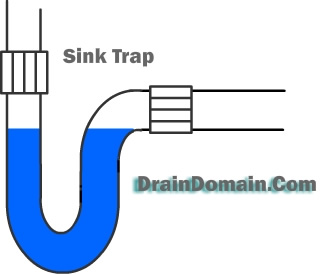 Drainage systems are designed so that no matter what goes on below ground level you should not get any venting at ground level or within the property. All external gullies should have a water trap to act as a barrier and the soil vent pipe is there to allow the foul air to vent above the eaves of a property. Likewise all internal fittings such as sinks, baths, toilets and showers should have water traps fitted and waste pipes from dishwashers & washing machines should also pass through a water trap of some description.. Drainage systems are designed so that no matter what goes on below ground level you should not get any venting at ground level or within the property. All external gullies should have a water trap to act as a barrier and the soil vent pipe is there to allow the foul air to vent above the eaves of a property. Likewise all internal fittings such as sinks, baths, toilets and showers should have water traps fitted and waste pipes from dishwashers & washing machines should also pass through a water trap of some description..
The first question we ask is usually how long has the problem being going on ?, if you have lived in the property for ten years and the venting started 18 months ago this tells us something has obviously changed somewhere for the problem to start, however if you have been in a new build property for two years and you have had venting from day one there is a fair chance that the problem is due to the poor design or installation of the drainage or plumbing system. We would then want to know if the venting is constant or if it comes and goes as again this can eliminate certain scenarios and obviously if you have had recent building or plumbing works undertaken this would be an area to investigate.
Recreating the exact same circumstances that caused the system to vent is often a problem for a contractor as `The law of sod` says that when we turn up on site all is April freshness itself with no sign of a bad odour anywhere, there are a couple of reasons for this such as the amount of flow passing through a main sewer increasing and stirring up the sediment and increasing the stench at certain times in the day. The flow rate of a sewer will increase first thing in the morning when everyone is getting up and using the bathroom and again in the evening when people get home, rainfall can dramatically increase the flow rate on older or combined sewer systems.
Typical Causes of Internal Venting From Drainage Systems
Blocked Or Lack Of A Soil Vent Pipe
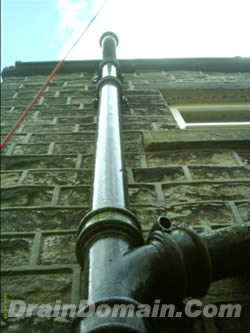 A soil vent pipe (SVP) not only allows foul air to vent from the drainage system it also allows air into the system, when an upstairs toilet is flushed a block of water drops down the 100mm soil vent pipe and if there is not an open vent at the top of the soil vent pipe a vacuum can momentarily occur behind this falling plug of water. If your bathroom sink, shower or bath waste pipes discharge directly into the soil vent pipe this vacuum will draw water out of their traps, once the water level in the traps drops to a certain level the barrier fails and you have in affect a direct vent from the drainage system into your bathroom until the next time water passes through the trap and the water level is restored. A soil vent pipe (SVP) not only allows foul air to vent from the drainage system it also allows air into the system, when an upstairs toilet is flushed a block of water drops down the 100mm soil vent pipe and if there is not an open vent at the top of the soil vent pipe a vacuum can momentarily occur behind this falling plug of water. If your bathroom sink, shower or bath waste pipes discharge directly into the soil vent pipe this vacuum will draw water out of their traps, once the water level in the traps drops to a certain level the barrier fails and you have in affect a direct vent from the drainage system into your bathroom until the next time water passes through the trap and the water level is restored.
The above scenario can also affect kitchen sinks if they are plumbed directly into a soil vent pipe and we often find downstairs toilets and en suite bathrooms with no vent system at all, if a hand wash basin is plumbed into the pan connector at the back of toilet the same syphonic action occurs.
There is a simple test you can do if you think that the above applies to your situation, just leave the plug in the sink, bath or shower and put an inch of water over it and this should stop the venting, likewise just run water through the traps after each flush of the toilet to see if this cures the problem.
If you have confirmed that a syphon is indeed drawing water from the traps you need to establish if there is a vent on the system and if so if it is blocked, blockages to the top of soil vent pipes can often be the result of nesting birds. On more modern properties the vents finish within the roof space and have a durgo air admittance device fitted, these valves are prone to failing due to dust and loft insulation fibres but if by some minor miracle you can reach the valve they are easy enough to dismantle and clean out.
If its a downstairs WC, an en suite or an additional wash room your having problems with you can install an air admittance valve behind the WC there are also traps that you can install on sinks, baths etc with a built in valve that allows air into the system when required.
Poor Plumbing Connection To Soil Vent Pipe 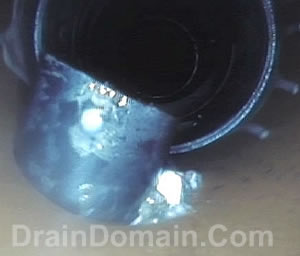
The vast majority of internal soil vent pipes are boxed in and hidden from view, a bad connection from a 35mm waste pipe onto the SVP (like the one in the image to the right) may not necessarily leak if the defect is in the crown of the connection but it can cause venting.
These types of problems are usually caused by the plumber making his own connection rather than installing a factory made one, this would normally entails drilling a hole into the soil vent pipe and pushing the waste pipe into it before smearing a generous amount of silicone sealant around the point of the connection before heading off to the golf course.
Similar problems arise when new bathrooms or kitchens are installed and the fitter instead of capping off a redundant waste connection using a purpose made sealed cap sticks a ball of plumbers mate in the end of the pipe or a wedge of cardboard along with lashings of silicone. Surprisingly these bodged connections and caps can last for some time without causing problems and its usually other works later on that disturb or knock the pipe work and the seal is broken.
These can be a sod to discover and we would either try to survey the soil vent pipe and account for every connection or look for a particularly poor or bodged connection but this is not always so obvious when viewing from inside the pipe work, smoke testing the soil vent pipe is also affective but remember to disconnect the smoke alarm first.
Blocked Drainage System
When an external below ground drainage system is blocked or even partially blocked obviously the air within that system is a little bit more pungent than normal, when you flush a toilet that air can become trapped and it will be displaced by the water from a flushed toilet and this is usually what causes the toilet to be slow in draining, the gurgling in the traps in the bathroom and on the toilet itself is a side affect of this process as is the venting that follows. So its always prudent to lift any external manhole covers before you start dismantling your bathroom looking for the cause of the bad smells.
Internal Suspended Pipe work
The above applies to internal drainage and waste pipes often fitted between floor joists for upstairs bathrooms and en suites, these systems are typically installed with very little fall if any at all, usually in under sized pipe work with numerous changes of direction. Add a saniflow toilet (other models are available) and you a pumping waste and air into a half blocked system and the air will find its way up through one of the traps in the bathroom along with the bad odour's.
Internal Manholes
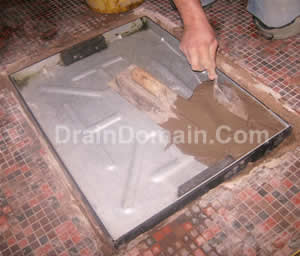 Many properties are extended often covering existing drainage systems and manholes, these chambers were initially designed to be outside of the property and for that reason are seldom air-tight. We find these covers in sub-floors, beneath extensions and often merely covered by carpets and other floor coverings. Many properties are extended often covering existing drainage systems and manholes, these chambers were initially designed to be outside of the property and for that reason are seldom air-tight. We find these covers in sub-floors, beneath extensions and often merely covered by carpets and other floor coverings.
They can be there for many years without causing a problem but a partially blocked system can force air up through the cover and frame, cast iron covers and frames corrode over time which can often seal the two together if this cover is lifted at any time to clear a blockage re-fitting the cover and forming a seal can be difficult . Any type of cover and frame that has to be forced up using hammers, chisels etc can become damaged and misshaped again breaking any kind of seal that there may of been in the first place.
Foul Water Sitting In A Trap
Pipe work can be partially blocked causing the level in the system to rise but not actually surcharge or overflow, this can allow foul water to enter the lowest trap typically the shower or bath which then starts to vent. I have also seen the same scenario in offices and schools where the toilets discharge into suspended pipe work running across the rear of several toilet pans, if this pipe work is level waste water can enter other pans causing terrible venting without actually discolouring the water in the toilets themselves.
The above also applies to external drainage when a partial or full blockage causes foul water to fill the outside gullies, if the gullies are beneath or local to air-bricks the foul air will enter the property.
New Washing Machine/Dishwasher
This one actually happened to me a few years back when we had a new kitchen fitted, in the good old days a plumber would drill through the external wall and plumb your waste pipes into the nearest gully (with no concern whether that gully discharged into a foul drainage system or a local brook in most cases). These days the trend seems to be to fit a trap on the kitchen sink with an additional inlet for washing machines, when the washing machine is on its final rinse or spin mode it can push out as much air as water, this air can displace the water out of the kitchen sink trap leaving a direct vent.
Disused Junctions & Branch lines
Extensions and conservatories are often constructed over external gullies or soil vent pipes which then have to be re-sited, there are strict guidelines as to how you cap off a redundant branch lines but quite often it is usually done with half a cement bag stuffed into the open end of the pipe or a piece of chip board lay over a disused gully top.
This in itself gives a direct vent to beneath the property which in the right circumstances can cause problems if the end of the pipe work is local to a sub-floor or wall cavity, again a partial blockage of a system can go unnoticed if the water can surcharge up the disused branch line and into the sub-soil area and as the ground becomes saturated damp problems and venting can occur.
These disused and poorly capped branch lines also give access into your property for rats, it is these little sods that tunnel and scratch there way into a wall cavity or sub-floor and at the same time create a direct vent as they go.
Leaking & Broken Drainage Pipes
Cracked, broken and fractured pipe work will allow water loss into the sub-soil area, if the leak is on the outlet of a gully or on the rest bend at the base of a soil vent pipe this is usually directly adjacent to the external wall of a property. For this reason we often find sub-floors that have standing foul water in them and again a partially blocked system will accelerate the water ingress. This obviously leads to foul air venting inside the property at the very least, with large volumes of water loss local to the house foundations often leading to subsidence.
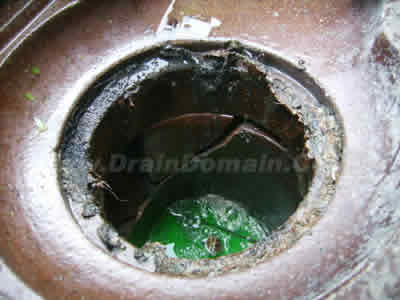 Leaking External/Internal Gully Pot Leaking External/Internal Gully Pot
A fractured gully pot will allow water loss that can find its way into sub-floors and cellars and as the water level drops the barrier from the sewer smells is lost, the water loss can be very slow compared to the flow that passes through the gully so the water level may only drop below the trap level every so often before it is topped up again. A typical scenario would be a rain water gully on a combined drainage system, during a prolonged dry spell the gully could in affect drain down and dry out giving a direct vent at ground level. If the gully is beneath an air brick the venting can manifest within the property.
Removal Of Interceptor Trap
Interceptor traps were installed many years ago to prevent gases from the sewer systems entering private systems ( not to prevent rodents access as many mistakenly think ), this was done when it was believed that sewer gases were a lot more harmful than they actually are and even at that time many local authorities refused to install them as they are prone to blocking.
For this reason it is a recognised practice to remove these traps on modern day systems as a well ventilated system can more than compensate for any sewer gases that may enter the runs, however the removal of an interceptor trap can highlight any problem areas on a system such as an ill fitting manhole cover or leaking gully pot.
|

 Drainage systems are designed so that no matter what goes on below ground level you should not get any venting at ground level or within the property. All external gullies should have a water trap to act as a barrier and the soil vent pipe is there to allow the foul air to vent above the eaves of a property. Likewise all internal fittings such as sinks, baths, toilets and showers should have water traps fitted and waste pipes from dishwashers & washing machines should also pass through a water trap of some description..
Drainage systems are designed so that no matter what goes on below ground level you should not get any venting at ground level or within the property. All external gullies should have a water trap to act as a barrier and the soil vent pipe is there to allow the foul air to vent above the eaves of a property. Likewise all internal fittings such as sinks, baths, toilets and showers should have water traps fitted and waste pipes from dishwashers & washing machines should also pass through a water trap of some description..  A soil vent pipe (SVP) not only allows foul air to vent from the drainage system it also allows air into the system, when an upstairs toilet is flushed a block of water drops down the 100mm soil vent pipe and if there is not an open vent at the top of the soil vent pipe a vacuum can momentarily occur behind this falling plug of water. If your bathroom sink, shower or bath waste pipes discharge directly into the soil vent pipe this vacuum will draw water out of their traps, once the water level in the traps drops to a certain level the barrier fails and you have in affect a direct vent from the drainage system into your bathroom until the next time water passes through the trap and the water level is restored.
A soil vent pipe (SVP) not only allows foul air to vent from the drainage system it also allows air into the system, when an upstairs toilet is flushed a block of water drops down the 100mm soil vent pipe and if there is not an open vent at the top of the soil vent pipe a vacuum can momentarily occur behind this falling plug of water. If your bathroom sink, shower or bath waste pipes discharge directly into the soil vent pipe this vacuum will draw water out of their traps, once the water level in the traps drops to a certain level the barrier fails and you have in affect a direct vent from the drainage system into your bathroom until the next time water passes through the trap and the water level is restored.
 Many properties are extended often covering existing drainage systems and manholes, these chambers were initially designed to be outside of the property and for that reason are seldom air-tight. We find these covers in sub-floors, beneath extensions and often merely covered by carpets and other floor coverings.
Many properties are extended often covering existing drainage systems and manholes, these chambers were initially designed to be outside of the property and for that reason are seldom air-tight. We find these covers in sub-floors, beneath extensions and often merely covered by carpets and other floor coverings.  Leaking External/Internal Gully Pot
Leaking External/Internal Gully Pot
